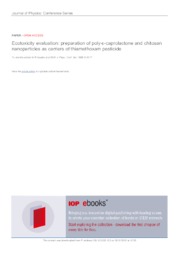Ecotoxicity evaluation: preparation of poly-e-caprolactone and chitosannanoparticles as carriers of thiamethoxam pesticide.
Ecotoxicity evaluation: preparation of poly-e-caprolactone and chitosannanoparticles as carriers of thiamethoxam pesticide.
Autoria: ASSALIN, M. R.; SANTOS, L. D. L. dos; SOUZA, D. R. C. de; ROSA, M. A.; MOLTOCARO, R. C. R.; CASTANHA, R. F.; DONAIRE, P. P. R.; DURAN, N.
Resumo: Abstract: The transmission of Huanglongbing (HLB) disease on citrus plants is through dissemination of the bacteria Candidatus Liberibacter ssp, by Diaphorina citri psyllid, its insect vector. Chemical control of the psyllids, and thiamethoxam (neonicotinoid insecticide) is one of the active ingredients used in the control of HLB. This insecticide is water soluble, unstable and rapidly degraded by photolysis. Pesticide nanoformulation is one of the strategies to control release of active compound as well as protection for premature degradation. Thus, studies of the effectiveness of encapsulated pesticide formulations are extremely important for enabling its use in agriculture. This study reports the encapsulation of the insecticide thiamethoxam in polymeric particles from poly-?-caprolactone (PCL) and chitosan by double emulsion and solvent evaporation method using different concentrations of chitosan and two Pluronic (poloxamer) copolymers, F 127 and F68. These nanoparticles were characterized in terms of size, zeta potential, polydispersity, and encapsulation efficiency. The encapsulation efficiency, measured by liquid chromatography was 34%. The nanoparticles obtained from optimized conditions resulted in homogeneous and monodisperse particles with a positive superficial charge. The microalgae Raphidocelis subcapitata (bioindicator chloroficea) and microcrustacean Artemia salina, were used to evaluate the ecotoxicity of nanopesticide in comparison to pesticide already in the market. The ecotoxicity study demonstrated that nanopesticide was less toxic that commercial formulations in the studied conditions.
Ano de publicação: 2019
Tipo de publicação: Artigo de periódico
Unidade: Embrapa Meio Ambiente
Palavras-chave: Ecotoxicology, Inseticida, Nanoparticles, Nanopesticidas, Nanopesticides, Pesticides, Toxicity, Toxidez
Observações
1 - Por padrão são exibidas publicações dos últimos 20 anos. Para encontrar publicações mais antigas, configure o filtro ano de publicação, colocando o ano a partir do qual você deseja encontrar publicações. O filtro está na coluna da esquerda na busca acima.
2 - Para ler algumas publicações da Embrapa (apenas as que estão em formato ePub), é necessário ter, no celular ou computador, um desses softwares gratuitos. Sistemas Android: Google Play Livros; IOS: iBooks; Windows e Linux: software Calibre.
Acesse outras publicações
Acesse a Base de Dados da Pesquisa Agropecuária (BDPA) para consultar o acervo completo das bibliotecas da Embrapa.

